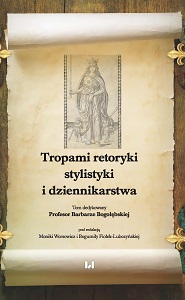Inicjacja przekazu artystycznego
Artistic Inspiration: How to Provoke Some Inspirational States for Creative Actions
Author(s): Zofia Władyka-Łuczak
Subject(s): Language and Literature Studies, Applied Linguistics
Published by: Wydawnictwo Uniwersytetu Łódzkiego
Keywords: artistic inspiration;creativity;visual communication;composition;formal structure of the image;formal narration;theory of vision;verbal communication;visual communication
Summary/Abstract: The article “Initiation of the artistic message” is an attempt to answer the question: When and for what reason does the initiation of the artistic message appear? The analysis leading to the final conclusion was carried out on the basis of autoethnographic analysis from the process of creating the „Monument to the Origins of the City of Lodz”. The main theme was the search for the border between the procreative state and the creative one during the artist’s work on the work. The analysis shows that: „Regardless of whether I’m working on a sculpture that was commissioned or sculpted only for myself, the process of initiating pre-creative and creative states looks similar. I always start my work from collecting materials. I proceed as the constructivists want, I carry out the recognition of elements relating to various differential systems. […] I am aware t that the expected state of transition from pre-creative to creative state can occur at any time. Today, after many years, I know that it is not worth assessing the value of the collected materials, the initiation of the creative state will come by itself ”. The essence of initiating a creative attitude is to develop the skill of observing the reality surrounding the artist, and what is more important to develop the skills of extracting from it what already in all this complicated process is what we used to call – inspiration. The boundary of the pre-creative and creative state arises at the moment when the artist makes the decision to transfer the noticed fragment of reality to the work being created. The evaluation of the value of a work of art is a separate issue that has been omitted in the article
Book: Tropami retoryki, stylistyki i dziennikarstwa. Tom dedykowany Profesor Barbarze Bogołębskiej
- Page Range: 217-230
- Page Count: 14
- Publication Year: 2019
- Language: Polish
- Content File-PDF

